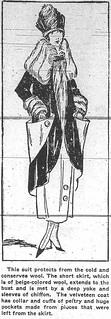A month later came the report that the federal government was asking for the cooperation of designers and manufacturers of clothing, as well as retail purchasers, in limiting the use of wool to no more than 4½ yards per garment. The military needed wool for uniforms, blankets, etc. To do your part for wool conservation, said the government, wear — um, animal skins? Well, yes, if you liked; but the important thing was to eliminate spectacularly wasteful flourishes in women's fashions — the long jackets, the full skirts. Skirts were to be cut "as short as decency will allow." (It's an interesting side note that the government focused on manufacturers and purchasers because "the great majority of women" now bought clothing ready to wear, rather than making it at home.)
Nor was cotton a patriotic alternative for full skirts and long jackets — the military needed cotton too.
The conservation effort relied on the imaginations of designers and the cooperation of purchasers.
One of the quick ways which has leaped into fashion for women to conserve wool for the army is the use of a short, slim separate skirt with a cutaway coat of velveteen, heavily lined. Women who have such costumers declare that they will wear these skirts with corslet blouses of soutached silk and satin in the spring, thereby saving cotton for the government.Silk apparently was not in great demand by the military — I don't think there was a great deal of parachuting done in World War I.
Hats made of worsted have already been replaced by those of satin and velvet.
Entire coat suits made of worsted have narrow bias flounces mounted on a taffeta or satin foundation. The short jacket which goes with these skirts is so heavily trimmed with fur and has such a wide waistcoat of satin or matelasse that it can be considered a bit camouflage.
The article was illustrated by a sketch to demonstrate how patriotism and fashion might intersect.

(Click on image to enlarge)
Fashions of the early 20th century had been slowly moving toward the shorter, lighter and narrower, so the war did not introduce the trend, but probably accelerated it.
Sources:
♦ "Ask Women to Cut Out Gauzy Dress." Hobart News 6 Dec. 1917.
♦ "Use of Wool in Clothes Limited." Hobart News 10 Jan. 1918.

No comments:
Post a Comment